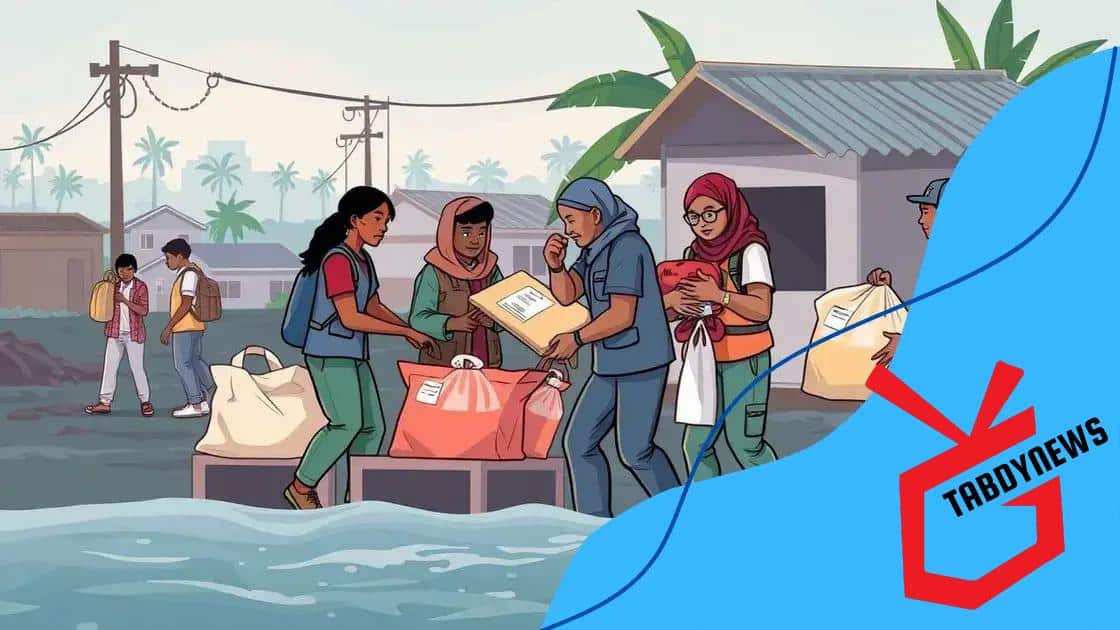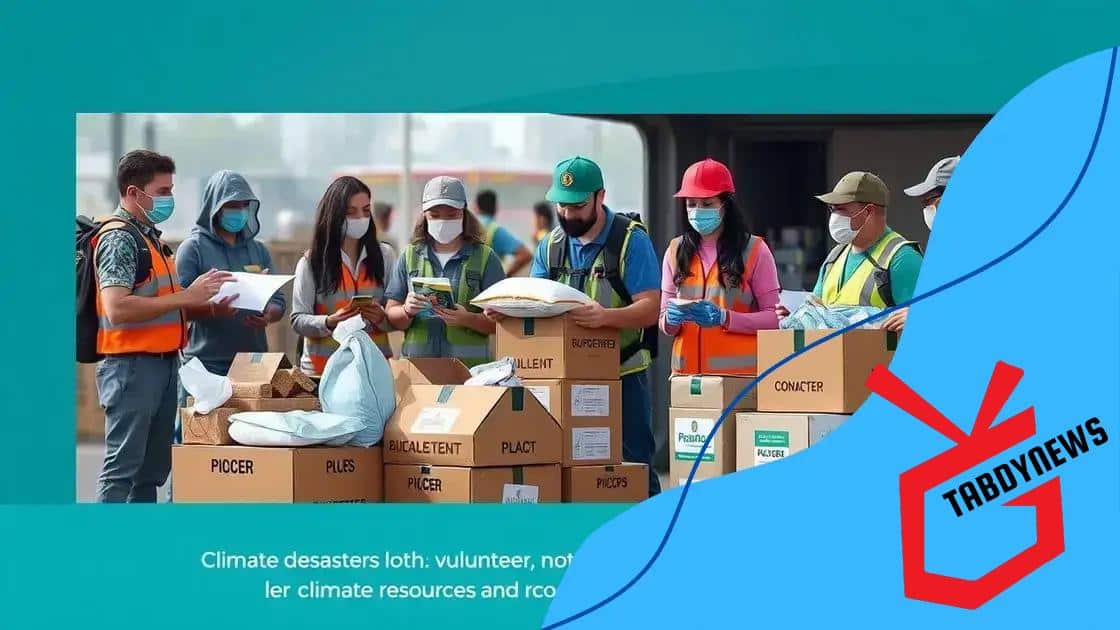Emergency assistance for climate disaster victims is crucial now

Emergency assistance for climate disaster victims is crucial for providing immediate support, ensuring food, shelter, and medical care while facing challenges such as logistics and communication during recovery efforts.
Emergency assistance for climate disaster victims serves as a lifeline for those affected by natural calamities. Have you ever wondered how timely support can transform a community’s recovery? Let’s dive into the essential role of emergency aid in these dire situations.
Understanding climate disasters and their impact
Understanding climate disasters and their impact is crucial for communities worldwide. These events can change lives quickly, leaving people vulnerable and in need of support.
What are climate disasters?
Climate disasters refer to severe events like hurricanes, floods, wildfires, and droughts that occur due to climate change. Each disaster affects communities differently, depending on location and preparedness.
Key impacts of climate disasters
- Loss of life and injuries
- Destruction of homes and infrastructure
- Displacement of communities
- Economic downturns and loss of livelihoods
These disasters often lead to long-term challenges. After a flood, for example, families may struggle to find new homes or jobs. Emergency assistance plays a vital role in helping victims rebuild their lives.
Many communities face depletion of resources during a climate disaster. Resources such as food, water, and medical supplies become scarce. Emergency plans must be prepared in advance to deal with these situations.
Education and awareness about climate disasters are key to reducing their effects. When people understand the risks, they can take steps to prepare. Simple actions like creating emergency kits or knowing evacuation routes can save lives during a crisis.
Conclusion
Understanding the nature of climate disasters helps communities be better prepared. This knowledge allows for effective response and recovery efforts to support those affected.
The role of emergency assistance
The role of emergency assistance is critical during climate disasters. When disaster strikes, timely help can make all the difference in saving lives and supporting recovery.
What is emergency assistance?
Emergency assistance includes any aid provided to individuals and communities affected by disasters. This can involve medical aid, food supplies, and temporary shelters. Organizations like the Red Cross and local governments play a vital part in delivering these services.
Key components of emergency assistance
- Medical support: Providing urgent medical care to those injured in the disaster.
- Food and water: Distributing essential supplies to sustain life in the aftermath.
- Shelter: Offering temporary housing solutions to those who have lost their homes.
- Emotional support: Addressing mental health needs during crises.
These components work together to stabilize communities during challenging times. When support arrives quickly, it helps individuals feel safer and more secure. For instance, restoring access to clean water can prevent diseases that might arise from unsanitary conditions after a disaster.
Moreover, emergency assistance also focuses on long-term rebuilding efforts. While immediate aid is essential, recovery programs are equally important. These programs help communities rebuild infrastructure and restore livelihoods.
Training volunteers and local responders is crucial for effective emergency assistance. Preparedness and training ensure that communities are ready to act quickly when disasters occur, maximizing the impact of the aid provided.
How to mobilize resources effectively

Mobilizing resources effectively is essential during climate disasters. When an emergency happens, every second counts, and having a clear plan can ensure that help reaches those in need quickly.
Understanding resource mobilization
Resource mobilization involves gathering and coordinating supplies, funds, and people to provide the necessary aid. This process requires clear communication and strong leadership.
Steps to mobilize resources
- Assess needs: Determine what resources are required by evaluating the situation on the ground.
- Engage local organizations: Collaborate with community groups and NGOs already in the area. They have local knowledge that can enhance efficiency.
- Use social media: Leverage social platforms to raise awareness and gather donations or volunteers.
- Coordinate with authorities: Work with governmental agencies to ensure that efforts are aligned and effective.
Being proactive is crucial. Before a disaster strikes, it’s wise to create a plan for mobilizing resources. This planning can include establishing partnerships with local businesses that can provide supplies or services in times of need.
Training volunteers ahead of time also adds value. When community members know their roles, they can act quickly and reduce confusion during crises. Frequent drills and workshops can prepare them for real-life situations.
Additionally, establishing an inventory system can help track available resources. When aid is mobilized, knowing what supplies are on hand allows for immediate distribution without delays.
Success stories of aid in action
Success stories of aid in action highlight the incredible impact that timely assistance can have during climate disasters. These real-life examples inspire hope and demonstrate the power of community support.
Case study: Hurricane relief efforts
During Hurricane Harvey, communities in Texas faced immense flooding. Organizations mobilized quickly to provide relief. Volunteers delivered food, water, and medical supplies to affected families. This coordinated effort demonstrated how effective emergency assistance can save lives and restore normalcy.
Key elements of success
- Swift response: Rapid mobilization of resources is crucial in minimizing damage.
- Community engagement: Local volunteers played an essential role in ensuring that help reached those in need.
- Donation drives: Fundraising events were set up to gather necessary supplies.
- Collaborative approach: Partnerships between local organizations and national agencies enhanced the effectiveness of aid distribution.
Another inspiring example comes from the wildfires in California. Many residents came together to support those who lost their homes. They provided shelter, meals, and emotional support to help families recover. The community’s resilience in times of crisis shows how aid can change lives for the better.
These success stories emphasize the importance of planning and preparedness. By training volunteers and establishing resource networks, communities become better equipped to respond to disasters. Having a strategy in place allows for a quicker recovery and helps individuals feel supported.
Challenges in delivering aid to victims
Challenges in delivering aid to victims of climate disasters can hinder recovery efforts. Understanding these obstacles is key to improving how we respond in times of crisis.
Logistical obstacles
One of the biggest hurdles is logistics. Transporting resources to affected areas can be complicated. Roads may be damaged, or there could be unsafe conditions. This can delay the delivery of essential supplies like food, water, and medical assistance.
Communication breakdowns
Effective communication is vital during disasters. However, lines of communication often fail. Power outages can disrupt cell service, making it hard for aid workers to coordinate their efforts. Establishing reliable communication methods ahead of time can mitigate these issues.
Resource limitations
- Lack of funding: Limited financial resources can restrict the amount of aid that can be provided.
- Insufficient supplies: Often, there is not enough food, water, or equipment to meet the high demand.
- Volunteer shortages: The need for trained volunteers increases during disasters, but they may not always be available.
- Competition for resources: Organizations may compete for the same resources, leading to confusion and inefficiency.
Another significant challenge is cultural differences. In some regions, customs and traditions can impact how aid is received. Respecting local customs is crucial for effective delivery and ensuring that communities are comfortable with the assistance provided.
Finally, post-disaster mental health issues can arise among victims. Psychological trauma may prevent individuals from seeking help or accepting aid. Addressing these emotional needs is essential to creating a supportive recovery environment.
FAQ – Frequently Asked Questions about Emergency Assistance for Climate Disaster Victims
What are the main challenges in delivering aid during a climate disaster?
The main challenges include logistical obstacles, communication breakdowns, limited resources, and cultural differences in communities.
How can communities effectively mobilize resources for disaster relief?
Communities can mobilize resources by assessing needs, engaging local organizations, using social media to gather support, and coordinating with authorities.
What role do success stories play in emergency assistance?
Success stories showcase the impact of timely aid and inspire hope, demonstrating what effective collaboration and community support can achieve.
How can training volunteers improve disaster response?
Training volunteers ensures they are prepared to act quickly and effectively during a disaster, which enhances the overall response and recovery efforts.





